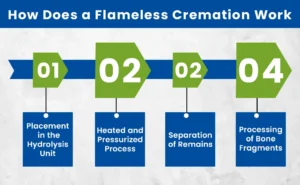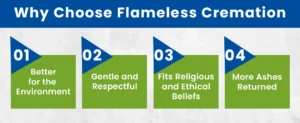Last Updated on: July 11th, 2025
- Licensed Agent
- - @M-LifeInsurance
Today people are more conscious about environment and they are looking for eco-friendly ways to handle end of life choices. One of the greatest option is flameless cremation also called alkaline hydrolysis. This method is more environment friendly and it does not use any fire like the regular cremation. In this detailed guide we will explain what flameless cremation is and how it works, and why families are choosing this gentle and respectful process.
What is Flameless Cremation?
Flameless cremation is the process in which the cremation service homes are using a water based way to care for a body after death. In this process they use chemicals with water and heat to help the body break down. This process is different from regular cremation, which uses fire. This process is also known as aquamation, water cremation or alkaline hydrolysis. This process is copying the natural process that happens under the ground when a body breaks down after burial. But it happens much faster, in just a few hours under a safe and controlled setting.
Many people think that this process is more eco friendly. There are alot of funeral homes offering this service to make the environment more clean and green.
How Does a Flameless Cremation Work?
Before having the understanding of how flameless cremation works, it is very important to know a little about the alkaline hydrolysis process. In this method, the body is placed in a special stainless steel container filled with the mix of 95% water and 5% gentle chemicals that is alkali. Here we will understand the step by step breakdown of the process.
1. Placement in the Hydrolysis Unit
The body is respectfully placed in a special stainless container filled with the water-alkali solution.
2. Heated and Pressurized Process
The container is heated to about 300°F (149°C), and pressure is added to stop the water from boiling. Over 4 to 8 hours, the solution breaks down the body’s tissues into basic organic components.
3. Separation of Remains
After this process has been done, only clean liquid and some bone pieces are left in the container. This liquid is made up of the amino acids, sugar, salt and some soap. After the cremation is complete, the liquid is safe to release back into the environment through the water treatment system.
4. Processing of Bone Fragments
The bone pieces that are left are taken out, dried and turned into fine white powder. This is also like the ashes from the regular cremation. This powder is then given back to the family for the final ceremony.

Is Flameless Cremation Safe and Legal?
Yes, flameless cremation is a very safe and eco-friendly option used by the funeral homes. This process helps reduce harm to the environment. Let’s have a look at how this process is safe.
Eco-friendly
The process of flameless cremation uses less energy and doesn’t release harmful gases.
Low Carbon Footprint
It creates up to 90% less pollution than flame cremation. So it will leave fewer carbon footprints.
Gentle Process
It also uses water and natural substances instead of high heat.
More Ashes Returned
Families usually get more ashes because the process is softer. And they get the fine powder of bones in an urn for the last ceremony.
Safe Byproducts
The leftover liquid is clean and also non-toxic; it does not create any damage to the environment when released back through the water treatment system.
Minnesota was the first U.S. state that make flameless cremation legal. The Mayo Clinic in Rochester helped support this law because this process of cremation is better for nature and works well for people who donate their bodies for medical study.
Cost Of Flameless Cremation
There is one common question that many families ask, which is about the total cost of the flameless cremation. The price of this process depends on where you live, which cremation company you choose and what other services are included in the flameless cremation package.
How Much Does Life Isurance Cost?
Average Cost of Flameless Cremation:
- Basic Flameless Cremation: $1,500 – $3,000
- With Memorial Services: $3,000 – $5,000+
Flameless cremation cost about the same and sometimes a little extra, depending on the area. But there are a lot of families who feel that the extra cost is worth it because it is saving the environment and also the process is gentle.
Why Choose Flameless Cremation?
There are so many families who are choosing flameless cremation because it is better for the environment and matches their values about protecting Mother Nature. Here are the main reasons why families prefer this option
Better for the Environment
Flameless cremation does not release any harmful chemicals, so it is cleaner and a greener choice.
Gentle and Respectful
The process is very gentle and natural, similar to how body breaks down over time. Many families say that it feel more peaceful and respectful.
Fits Religious and Ethical Beliefs
Some people don’t feel comfortable with the idea of regular cremation and fire. Flameless cremation offers a more calm and dignified option that fits better with their values.
More Ashes Returned
Because the process is gentle, this produces more ashes of your loved one which can bring extra comfort to families.

Flameless Cremation vs. Traditional Cremation
| Feature | Flameless Cremation | Traditional Cremation |
| Uses Fire? | No | Yes |
| Emissions | Minimal | High CO₂, mercury |
| Energy Consumption | Lower | Higher |
| Environmental Impact | Low | High |
| Remains Returned | More (white powder) | Less (gray ash) |
| Cost | Slightly higher | Slightly lower |
| Availability | Limited (but expanding) | Widely available |
This comparison makes it clear why flameless cremation is seen as the cremation method of the future.
Final Thoughts
Flameless cremation is a new gentle and eco- friendly way to say goodbye to your loved ones. You have to choose this because this is environment friendly and peaceful process. No harmful gases and chemicals released in air and the earth will be save from any toxins. This process is more likely to the natural process of body after the burial but this is fast and take less time as compared to the natural decomposition.
flameless cremation is the best option, If you want a peaceful and meaningful goodbye to your loved one.
Ready to Make a Greener Choice?
If you’re looking for an environmentally conscious and gentle way to say goodbye to your loved one, flameless cremation is the right option for you.
Choose a farewell with us that respects both your values and the planet.
FAQs
1. Is flameless cremation safe for the environment?
Yes , flameless cremation is safe for the environment because the process does not create any greenhouse gases so this is considered as the great option for the safety of the environment.
2. Does it smell or leave residue?
No. The system is closed, so there is no bad smell. Also the leftover parts are clean, not harmful, and easy to treat with water.
3. Can I still have a memorial or funeral service?
Absolutely. Flameless cremation can be included in any end-of-life plan, like viewings, religious services, or scattering the ashes.

Joyce Espinoza, Expert Life Insurance Agent
Joyce Espinoza is a trusted life insurance agent at mLifeInsurance.com. She’s been in the insurance industry for over ten years, helping people, especially those with special health conditions to find the right coverage. At MLife Insurance, Joyce writes easy-to-understand articles that help readers make smart choices about life insurance. Previously, she worked directly with clients at Mlife Insurance, advising nearly 3,000 of them on life insurance options.




